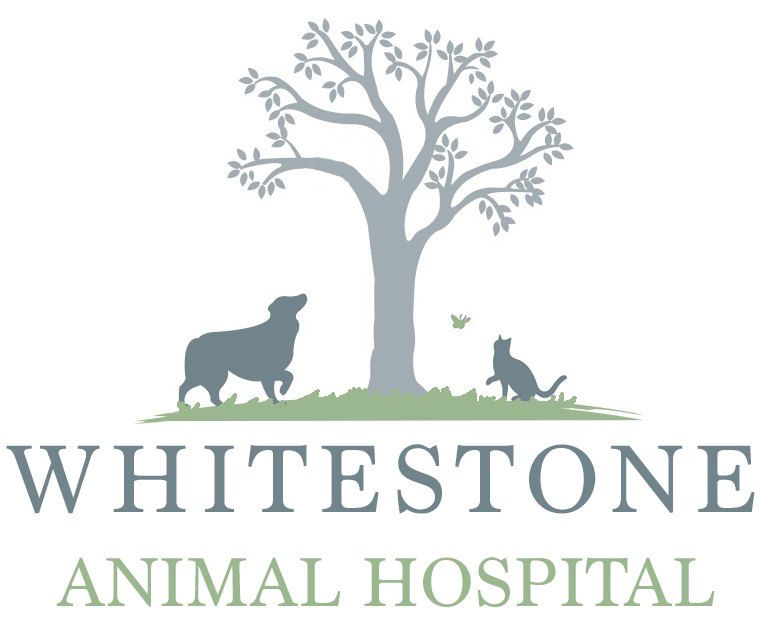Pet Dental Care
AppointmentAt Whitestone Animal Hospital, dental care is a huge priority and passion. According to the American Veterinary Dental Society, 70% of adult cats and 80% of adult dogs show symptoms of oral disease. Exceptionally bad breath, a brownish plaque at the base of the teeth, excessive drooling, sore or bleeding gums when eating or chewing, and decreased appetite can all be signs that a pet’s teeth require attention. Periodontal disease is a term we use that refers to more than just the tartar that you see on your pet’s teeth. It refers to the disease that affects the gums and the tissues that keep your pet’s teeth healthy and forms the structure to keep their teeth in their mouth. There are several factors that go into a dental disease. Some are genetic which you don’t have control over, and other like diet, home dental care, and regular dental cleanings and exams.
What to expect if your pet is having their teeth cleaned at Whitestone Animal Hospital.
Anesthesia is always a concern, and we don’t take it lightly. It is necessary for our animal friends for us to get a good exam of both sides of the teeth and examine and clean along the gum line. Examining these areas and cleaning them is stressful and uncomfortable for your pet if they are awake. There is also expensive equipment involved in taking dental radiographs that requires having a pet full asleep before placing this equipment in their mouth. All dental patients are treated like any regular surgery patient with the same care in monitoring vitals, fluids and temperature support. Please see our surgery information page for more details on anesthesia procedures. Many pets are up and looking around within 15-20 minutes after a dental cleaning. We like to watch them for about two hours at a minimum before sending them home.
Prep: A single injection of antibiotics is given. We have pulled away from sending pets home with oral antibiotics for routine cleanings. Injections of anti-inflammatories are given if extractions are done and an injection of Cerenia is given to help with possible post-op nausea.
Step One: Chlorhex (antibacterial) rinse is applied lightly to all the teeth, and the tartar is scaled off all the teeth by an experienced technician.
Step Two: Full mouth dental radiographs are taken. This gives the doctor a visualization of bone health and the periodontal ligament that keeps the roots firmly attached in the mouth. We can also find abnormalities in the bone, teeth that haven’t erupted, deformed teeth, cysts and fractures of the jaw and teeth. These radiographs are also essential if extractions are needed to plan the best way to extract the tooth.
Step Three: The doctor examines the mouth, checks for any loss of gum attachment or pockets along the teeth, checks for absorption lesions and does an oral exam looking for masses. It is then determined if extractions are needed or if steps can be taken to save any compromised teeth. If caught early enough, a good cleaning and some specialized procedures can be done to save teeth that have signs of periodontal disease (disease of the bone and soft tissue structures keep the tooth in place).
Step Four: No one ever wants their pet to have teeth extracted. Unfortunately, this is not uncommon in the veterinary world. Cats have 30 teeth and dogs have 42. Several of these teeth have very shallow roots and with age tend to lose their attachment in the mouth. Some of these teeth are smaller than the top of a pencil. Infection or pulp exposure can also cause a pet to need teeth to be extracted. People worry about how pets will eat if they have teeth extracted when in fact they eat better once the diseased teeth are removed. Imagine trying to chew with an abscessed tooth or a tooth where the nerves are exposed? Recovery from dental extractions is usually quick for routine extractions, about 48 hours. Although, your veterinarian may advise altered feeding for up to two weeks depending on which teeth were lost.
Step Five: All teeth are polished to smooth out any defects the tartar may have left. This helps slow down plaque from adhering again.
Step Six: Oravet is applied. This is a wax-like material that repels plaque for up to two weeks. You can start brushing your pet’s teeth as it starts to wear off.
Step Seven: Your pet is woken up from anesthesia. Someone will be by their side until they are extubated (airway tube is removed) and it is responding well. Their temperature is taken, and vitals are checked frequently during the recovery period as it continues to recover from anesthesia in a warm cage with cozy blankets right in the treatment room.
Home Care: Many pets are running out the door after a routine dental. Some pets may be sore if they had extractions, but many pets do eat even when extractions are done. Some are even eating better already! They may have a mild cough from the tube placed in their airway as discussed in the anesthesia section.
We recommend this awesome cat toothbrush from Amazon.
Click here for great information about dentistry and your pet.

Address

Contact

Hours
Mon-Fri: 8:00 am - 6:00 pm
Sat: 8:00 am - 12:00 pm
Sun: Closed
*We close for lunch from 12:30pm to 1:30pm. Appointments during this time are by special request only.
